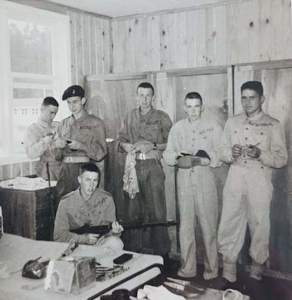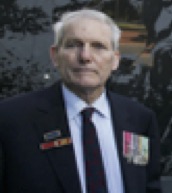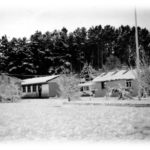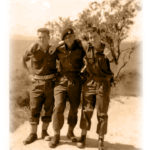
What’s in a (blog) title?
I chose “As You Were!” as the title for this blog after searching for a military term that would give a nod to our clubbie past. I also wanted a Te Reo version of the title. To this end, I talked with Wiremu, who is a workmate of mine and knows about such matters. After a period of reflection and korero with others, Wiremu came back with ‘I ngā wā o mua’ as a translation. He explained it as follows:
“In thinking about the words ‘as you were’ as a military command and also the words in a reflective context of how we were looking back, and how we could apply a Te Reo Māori component to this there were a number of things to consider. Māori do not often refer to time in the linear context solely. In discussing our tupuna or our ancestors we literally bring them, and all that came with them from the past into the present. The sharing of that knowledge and wisdom then resides from them to the future. ‘I ngā wā o mua’ therefore refers to all the possible permutations of time, the past, present and future.”
These words in turn reminded me of the responses we got from our classmates when, before Parkinson Class held its 40th reunion in 2004, we asked them to tell us what the best and worst parts were about being a RF Cadet. We published their replies in our reunion booklet. I also selected some of the more memorable responses and turned them into a poem (see “Military Arts” below), which I read at the School’s 70th Reunion in 2018.
Some of the poem’s phrases describing the “best parts of being a RF Cadet” came to mind when I read Wiremu’s explanation of ‘I ngā wā o mua’. They were: “Standards by which I have lived the rest of my life”, “The enduring bond that formed back then”, and “Foundations for coping with life’s challenges”.
In other words, “As you were” is also as we are now.
Marching-in
Happy 2020 to all!
Aaah, the joys of January – the month that the vast majority of RF Cadets marched-in to begin their life-changing experience. With great excitement, a little bravado, and a touch of nervousness, we said goodbye to our families, friends, and significant others, hopped on a train, ferry and/or bus and set-off for Waiouru. We did all this in accordance with our first military command – a “Movement Order”, which we received in the post. Just in case you had forgotten what it most likely said, here is the one that prospective 1966 Andrew Class members received in late 1965:
(Courtesy of Bob Rodgers, who got a copy from Prof Young and posted it on the RFCA Facebook page in January 2017.)
What followed our arrival is etched in our memories – the uniquely military reception, the removal of our civvie gears, and our allocation to a “section” (whatever that was). From the first morning of “marching” to the mess, to the daily revelations on how to clean, polish, iron, fold, lay out, dress, address others, walk in step, and shave (a novel experience for most), to the wonders of kit issue – all these early-day experiences led us with inexorable certainty to the start of “basic” later in the month. And that was how we started our Army Green (with accessories of Scarlet) journey.

(Photo of some 1965 Barrowclough Class boys early on, courtesy of John Kaldelis, who posted it on the RFCA Facebook page in 2019.)
Some of our RFCA Facebook Group members have been reflecting recently on their memories of marching-in and cadet life generally – what do you remember about the joys of January days?
Tribute – One of our own
Maurice David Stanley, MBE, 1931-2020. Presidential Citation (US), Unit Citation for Gallantry (Australia). Ex RF Cadet (Mead Class, 1949)
 In December 1949 Morrie Stanley graduated from Mead Class into the Royal New Zealand Artillery before being commissioned at the Royal Military College Duntroon. Morrie played a major part in the signature battle in which ANZAC troops were involved during the Vietnam War, the Battle of Long Tan. It was his actions, those of his FO Party, and the gunners and support staff of 161 Battery that saved D Company, 6 Battalion, Royal Australian Regiment, from annihilation. For his actions during this battle he was made a Member of the Military Division of the Most Excellent Order of the British Empire. His citation reads:
In December 1949 Morrie Stanley graduated from Mead Class into the Royal New Zealand Artillery before being commissioned at the Royal Military College Duntroon. Morrie played a major part in the signature battle in which ANZAC troops were involved during the Vietnam War, the Battle of Long Tan. It was his actions, those of his FO Party, and the gunners and support staff of 161 Battery that saved D Company, 6 Battalion, Royal Australian Regiment, from annihilation. For his actions during this battle he was made a Member of the Military Division of the Most Excellent Order of the British Empire. His citation reads:
NZ Gazette Number 39 dated 22 June 1967
CITATION
Captain Stanley enlisted in the New Zealand Army in January 1949 as a Regular Force Cadet. He entered the Royal Military College, Duntroon, Australia in January 1950 and graduated as a Lieutenant in December 1953. On his return to New Zealand in March 1954 he was posted to Central District Training Depot as an instructor, and served in this capacity until March 1957 when he assumed the appointment of Staff Captain 3rd Infantry Brigade. From March until September 1959 he commanded a platoon in 2 Battalion, The New Zealand Regiment and was then appointed Adjutant, 6 Light Anti Aircraft Regiment, Royal New Zealand Artillery. He held the appointment of a Battery Commander in 16 Field Regiment from March 1962 until March 1964 when he was posted to 4 Medium Regiment, Royal New Zealand Artillery as Battery Captain.
He served in 161 Battery in Vietnam from February 1966 until September 1966, recently returning to 161 Battery Depot in New Zealand.
On 18 August 1966 Captain Stanley was the Artillery Observation Post Officer attached to D Company, 6th Battalion, Royal Australian Regiment when this Company made contact with two enemy battalions in a rubber plantation in the Long Tan area Phuoc Tuy Province, South Vietnam.
D Company, 6RAR was quickly surrounded and suffered heavy casualties. Only the concentrated intense and accurate artillery fire immediately called down by Captain Stanley prevented D Company from being overwhelmed by sheer weight of numbers. Shortly after the action commenced the area was covered by a heavy tropical thunderstorm which hid enemy movement preventing the use of close air strikes in the area. Despite this lack of visibility and constant danger from enemy mortar and small arms fire in his exposed position, Captain Stanley continued for four hours to direct accurate close artillery fire onto the enemy’s repeated attacks against the Company. This artillery inflicted such heavy casualties on the enemy that it broke up all attacks and unquestionably prevented the enemy from over-running
D Company before reinforcements arrived.
Captain Stanley’s extreme courage, calmness under fire and devotion to duty under the most dangerous and adverse conditions were an outstanding example to all.
Many other ex-Cadets also played a major role in the success of the battle. They were: LBdr Murray Broomhall (Gentry). Murray was with Morrie in the FO party. The Gun Position Officer was Capt Peter Williams (Sinclair-Burgess). Peter was sadly killed by a booby trap on the eve of his RTNZ. With Peter in the CP were LBdr Paul O’Connor (Parkinson), LBdr Pat Duggan (Gentry), LBdr Woody Waddell (Bennett), and Sgt Brian Meyer (Puttick). On the gunline were Sgt Bob Wirihana (Puttick), Bdr Dennis Dwane (Weir), Sgt Fred Bigg-wither (Kippenberger), LBdr Kevin Burnell (Bennett), and Gnr Dave Kelsey (Parkinson). Keeping the guns serviceable was Cpl ‘Spanners’ McClellan, RNZEME (Sinclair-Burgess). Tending to the tannoy system after it was struck by lightning was Allan Birch, RNZ Sigs (Russell) and the attached Field Engineer Cpl Lennie Thomas, RNZE (Stewart). The BQMS was WO2 Ivan Trueman, RNZEME (Mead).
So we can see what a valuable contribution that the Regular Force Cadet School played in the biggest battle in which the Kiwis and Aussies were involved during the Vietnam War. All who participated in this battle demonstrated yet again that Forte Fortuna Juvat was more than just a motto.
Following is part of a NZPA article on Morrie from September 2010:
A former New Zealand Vietnam war hero who was recently presented with a bravery award for saving the lives of Australian soldiers has died.
Morrie Stanley, 79, from Campbells Bay on Auckland’s North Shore, died from cancer yesterday almost two months after being presented with an Australian Unit Citation for Gallantry, 44 years after the infamous battle of Long Tan in Vietnam in 1966.
The moving presentation at the Browns Bay RSA reduced the terminally ill Mr Stanley to tears.
He told NZPA he was stunned to get the award although he did not consider himself to be an emotional man.
Writers note. Of interest is the descriptor ‘infamous’ battle of Long Tan. Such is the world in which we live today.
(This article was compiled by Bob Davies.)
Military Arts
 Before Parkinson Class held its 40th reunion in 2004, we asked our classmates to tell us what the best and worst parts were about being a RF Cadet. Some of the more memorable responses are in this poem.
Before Parkinson Class held its 40th reunion in 2004, we asked our classmates to tell us what the best and worst parts were about being a RF Cadet. Some of the more memorable responses are in this poem.
The Best and the Worst of it
Learning how to march and swear
Church parades and mess fatigues
Isolation and feelings of loneliness
The long-term friendships made
Having to shave every day
Standards by which I have lived the rest of my life
Rigid enforcement of petty rules
The effect discipline has had on our lives
My best friend cutting his wrists
The unsurpassed esprit-de-corps
Wearing B.D.s without underpants
Foundations for coping with life’s challenges
A lack of female company
Being part of a family of brothers
Time spent in the bush
The lack of time for one’s self
Doing change parades on C.B.
Getting into trouble and not getting caught
Barrellings from senior class pricks
Trust and faith in your mates
Fish and chips on Sunday afternoons –
It wasn’t such a bad place
RF Cadet School Trivia – Brothers in Arms
 It was suggested to me by an ex Cadet the other week to include some questions in the blog about RF Cadets who were brothers. (None of the cadets in the photo are brothers, but they are in arms.) Have a crack at these:
It was suggested to me by an ex Cadet the other week to include some questions in the blog about RF Cadets who were brothers. (None of the cadets in the photo are brothers, but they are in arms.) Have a crack at these:
- How many sets of brothers can you name who were RF Cadets?
- Can you name any sets of brothers who were in the same Class?
- Can you name any sets of brothers who were not in the same Class but whose time at the School overlapped ?
- Can you name any sets of Cadet brothers who were not at the School at the same time?
- Can you name any sets of brothers who were at the School at the same time – one as a Cadet and the other on the staff?
Bonus Question: The ex-Cadet who made the brothers suggestion to me is my brother-in law. He had a brother who was also a Cadet. Who is my brother-in-law and what Class was he? (Clue: My brother-in-law’s brother was a past Patron of the RFCA.) Answer in the next Blog Post.
Australian-based Clubbies – our thoughts are with you
At this very stressful time for many in Australia, I would like to say, especially to our clubbie brothers who are based in areas particularly affected or threatened by the bush fires, that all RFCA members and ex-Cadets in general are thinking of you. Reach out to your mates as and when you need to and we will support you in whatever way we can.
RFCA News
Recent RFCA news will now appear in posts that are separate to As You Were! posts. For example, we will let you know how the Area Reps initiative is shaping up, bring you the latest on memorabilia items, and get your thoughts on what we are thinking about as it happens. Expect this to start up soon.
Don’t forget you can comment on any of the items in this post in the box below.
